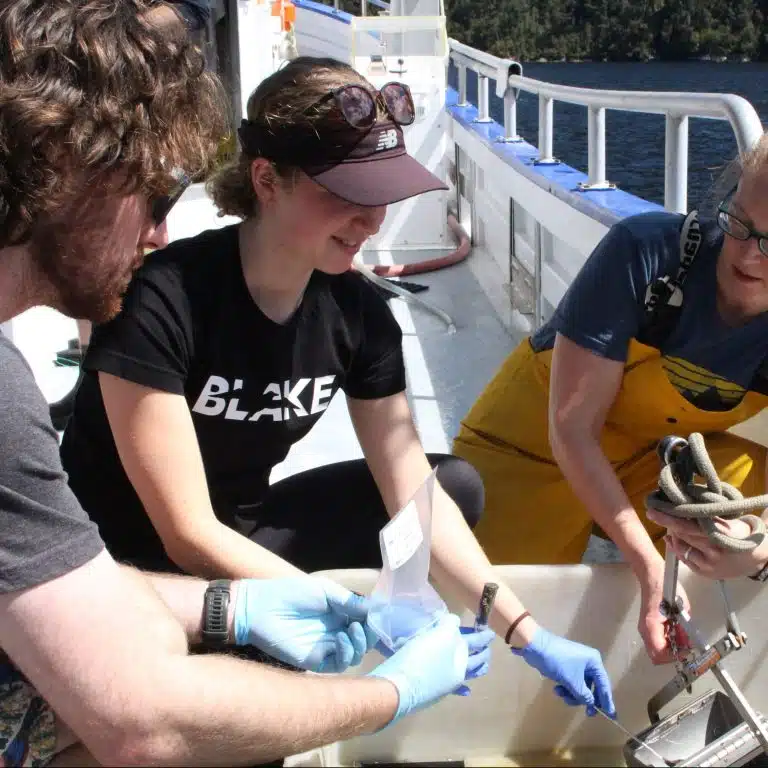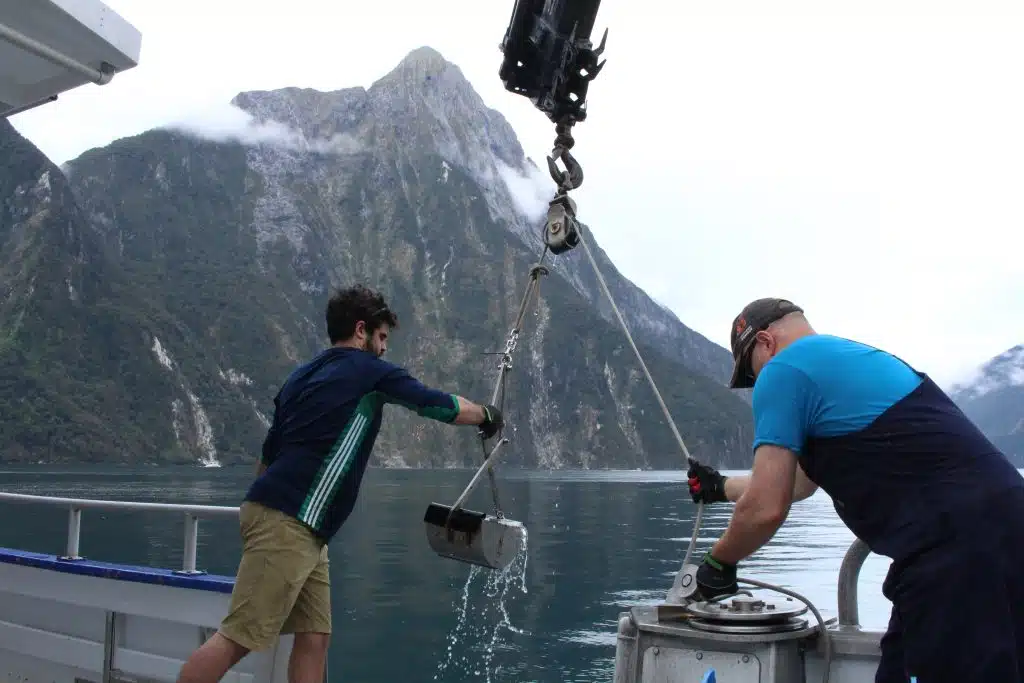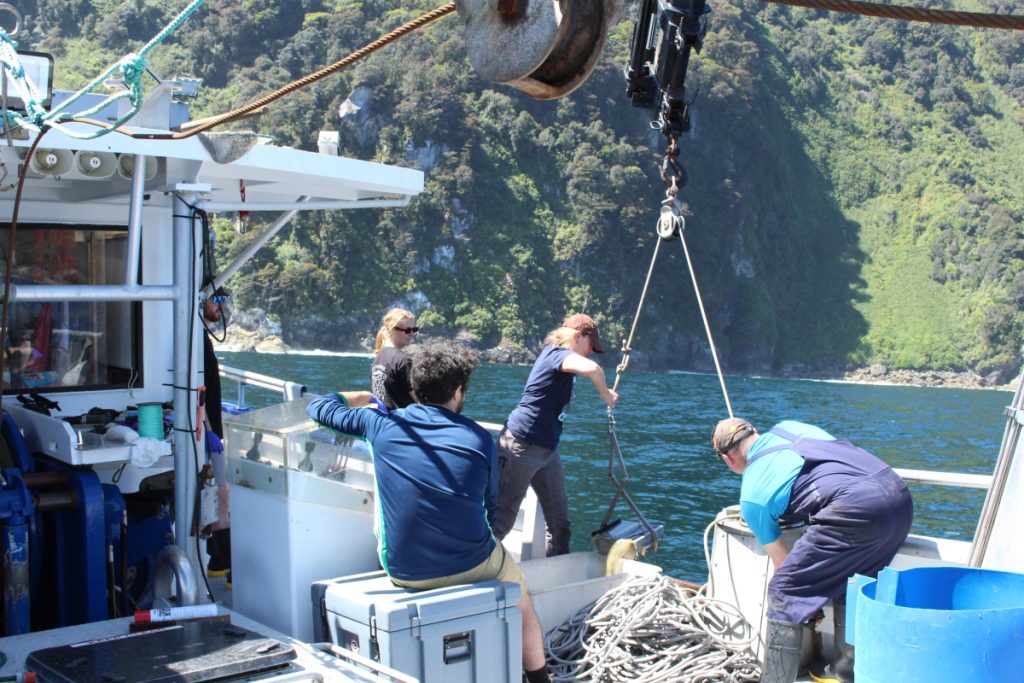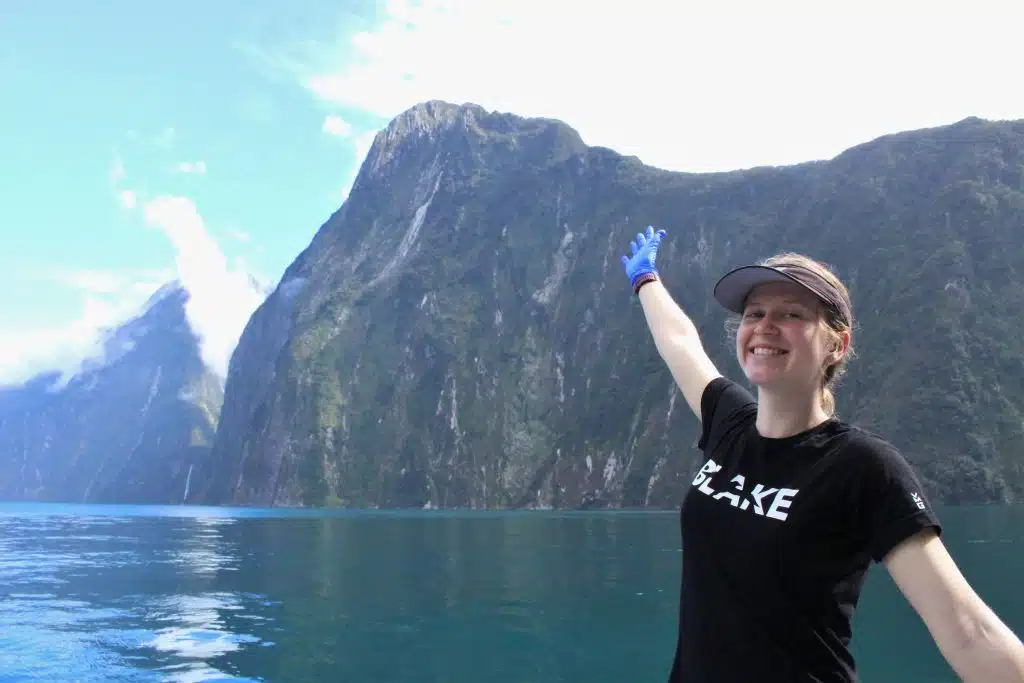Moody clouds and mist slowly sift through the bush as small rain showers pass through Dusky Sound. The water is still, reflecting the mountains encircling our small vessel, the Polaris II. The mountains stand stoically, marked with rugged outcrops and bush-caped ridgelines. The clouds hang low, obscuring the mountaintops. I cannot distinguish where they end and where the sky begins. The bush is verdant and dense. It covers almost every possible surface, with layers upon layers of green and brown creeping up massive rock faces and choking hanging valleys with an impenetrable thicket of vegetation. Sweeping landslides scar the faces of mountains, but already nature is claiming back its territory. The grunt of the winch motor cuts through the tranquillity, as I hear someone yell “good mud!”. The grab sampler has been winched up onto the boat from station number 156, and it’s full to the brim with thick black-brown mud.
The four weeks I spent in Fiordland as the BLAKE GNS Science Ambassador were breath-taking. An endless montage of waterfalls, mountains, mud, dolphins, rainbows, and the pure, rugged beauty of the fjords. I was working with a team of scientists from the University of Otago on a research expedition to investigate the role of Fiordland as potentially one of New Zealand’s largest carbon sinks. The project aims to find out how much carbon is stored in Fiordland, where carbon is distributed around the fjords, where the carbon comes from, and what are the main factors that influence its burial. The team will spend the next five years collecting mud, sampling water, and conducting other oceanographic measurements from different fjords in the region. This will allow the first deep analysis of the ability of fjords to hold carbon in the world, as well as providing us with a better understanding of the size and variability of carbon stores in New Zealand’s fjords, and their vulnerability to climate change and catchment management decisions.
Embarking for the fjords from Bluff, the 2022 research expedition took us through many of the region’s fjords; Long, Dusky, Doubtful, Bradshaw, Milford, and Breaksea. Across these fjords we recovered over 430 sediment samples, 14 sediment cores, oceanographic data from 36 different sites, and about 95km of seismic data. This marked the start of a multi-proxy approach to collecting carbon burial data in the fjords. Analysing sediment samples “grabbed” from the fjord bottom was one of the key tasks on the boat. These grabs brought up a variety of different sediments from sandy gravels to thick, smelly black mud. We also found a lot of different marine life such as urchins, worms, and even a sea cucumber. For each grab, we had to take up to four different samples for carbon/nitrogen concentrations, metals, organics, and environmental DNA (eDNA).
The latest New Zealand Climate Change Commission report identified that there is limited knowledge about carbon sinks, particularly for the carbon stored in oceans and coastal marine systems, also known as ‘blue carbon’. While we know that Fiordland is a likely “hotspot” for carbon sequestration in New Zealand, the sensitivity of Fiordland’s carbon sequestration capabilities to changing freshwater inputs from electricity generation and climate change remains unknown. It is important for scientists to determine the crucial tipping points for these ecosystems to implement effective environmental management strategies, anticipate its response to future climate change, and determine potential impacts to carbon processes in Fiordland from changes to human systems, such as with the use of Manapōuri Power Station to meet 100% renewable goals. If these tipping points are crossed, there will be a dramatic reduction in the efficiency of carbon sequestration in the fjords, resulting in increased global warming. The University of Otago and GNS Science researchers are aiming to fill this research gap to orient New Zealand on a stronger pathway to carbon neutrality.
Carbon is an essential element for life on Earth. It is not only part of the atmosphere, but it also makes up the molecules in our bodies and is bound up in the rocks beneath our feet. The carbon cycle is the natural flow of carbon throughout these different environments, from atmosphere, to organism, to Earth, and over again. Ecosystems, such as forests, grasslands, oceans, and fjords, are carbon sinks, which are environments that provide stable sites for carbon-rich sediments to accumulate. Scientists estimate around 18 million tonnes of organic carbon is buried in fjords around the world each year, equivalent to 11% of annual marine carbon burial globally. To address future climate challenges, globally and within New Zealand, it is important to understand the role that these fjords have in carbon burial and climate regulation.
It rains a lot in Fiordland – about 7 metres every year. Because of this, vast quantities of carbon are deposited in the fjords, with rivers and landslides rapidly eroding and transporting plant debris and sediment into the fjords. The carbon is effectively locked away as it is covered by sediments or settles to low oxygen environments deep within the fjord. This is a unique environmental process, providing an important climate regulation service. Harnessing this process will not help us to reduce the amount of carbon dioxide in the atmosphere, however, understanding its function can assist in informing conservation and catchment management decisions, as well as adding to existing knowledge about Earth’s broader climate system so that we can effectively think about climate change mitigation.
As an aspiring environmental engineer, the part of the trip that I found the most interesting was thinking about how engineering systems influence environmental systems. On the expedition, we spent a few days in Doubtful Sound, and made a visit to the tailrace outlet from the Manapouri Power Station. Here, freshwater from the lakes is diverted down vertical penstocks to generate electricity, where it is then flushed through a 10km tunnel through a mountain and into the fjord! Lake Manapouri’s power scheme – one of New Zealand’s greatest engineering achievements – has also long been seen as a touchstone for the inception of New Zealand’s environmental awareness as it was the focus of the country’s first politically influential environmental movement. The University of Otago and GNS Science’s research is aiming to determine the impact the power scheme is having on carbon burial processes. Although the dam may be key for New Zealand to reach 100% renewable energy goals, it may also be interrupting our natural climate change defence. I think that it is fascinating to think that 50 years later, the Manapouri Dam remains to be key to the interface between the environment and engineering. As a result, it is important to understand carbon sequestration processes in the fjords to improve how we design and operate our engineering systems to mitigate environmental impact.





